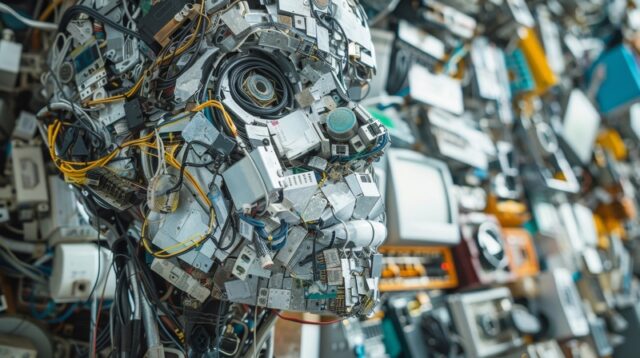Land of hope, glory and e-waste: Brits are set to become the biggest contributors to electronic waste this year, but why?

As technology evolves and becomes more accessible, providing new and exciting ways to make our lives easier, it’s easy to ignore the elephant in the room -- the huge amount of e-waste our appetite for consumption is causing. Ignorance has been bliss, but with research suggesting this year the UK could become the world’s biggest contributor to e-waste per head, transformative action is long overdue.
While our drive to have the latest technology is natural, we need to consider what happens to old devices when we upgrade.
Electrical and electronic equipment are estimated to be Europe’s fastest-growing source of waste, increasing by 3 percent to 5 percent year on year. Key to the problem is that products and delivery methods are advancing far faster than our understanding of how to dispose of them. We can now tap our phone and receive its replacement in an hour, but there is a lack of education among consumers about what can be recycled and where. As a result, global e-waste is rising five times faster than e-waste recycling.
Back in March, the parliamentary Environment Audit Committee reported that the UK Government has made very little progress in tackling the issue, with Chairman Phillip Dunne telling Environment Secretary Steve Barclay it had “yet to grasp fully the scale of the e-waste tsunami”.
So why is the UK creating more e-waste than other nations -- is it down to our general attitude towards tech or a hoarding instinct that leaves us holding on to old devices? Several studies point to this, such as research from Currys revealing that two-thirds (66 percent) of young people are more likely to bin than recycle their technology, and three in four (75 percent) are storing unwanted tech in their homes.
Another study, by Material Focus, estimates that Brits are stockpiling an average of 30 items in their homes, equating to 2.8 million tonnes of CO2 emissions that could be saved by households returning their small electricals to the economy.
It's hard to ignore these statistics, however I believe the problem stems fundamentally from a lack of awareness. As consumers cannot see directly the effects of hoarding their devices, it is unlikely they realize the problems this could be causing. They are also, in many cases, unfamiliar with the right way to recycle their e-waste. There are several solutions to combat this problem. All are simple to implement and can be hugely effective if relayed in a straightforward way that encourages participation. Like the “Dig for Victory” campaign created during the Second World War, the best chance of achieving success is by engaging households and businesses so that everyone wants to do their bit.
- Sustainability Begins at Home
We need to create a system based around reverse logistics, making it just as easy for used goods to be returned to manufacturers or disposed of properly as for them to be delivered to the consumer.
To support this idea, recycling measures such as bins and collections should be increased and heavily promoted. Implementing recycling as part of an everyday routine will ensure consumers think about how the process relates to all their waste, including technology.
- Enforcing Stricter Rules
The UK Government has been exploring proposals to strengthen legislation around business-to-business waste collection and the suggestion of new metrics to measure the success of any changes to the Waste Electrical and Electronic Equipment Directive (WEEE) regulations.
There needs to be greater accountability placed on the consumer, creating a bigger deterrent for those who breach the household waste duty of care and companies that breach WEEE.
- Learn From Other Countries
While Norway currently sits ahead of us as the biggest per capita contributor to e-waste, it has a much higher recycling rate, coupled with an active take-back scheme to improve management. The same is true of Switzerland who rank third on the e-waste naughty list. France, meanwhile, has a mandatory repairability index on electronic and electric products, assessing how viable they are to be repaired against criteria including documentation, disassembly and the price and availability of spare parts. This aims to increase the proportion of products that get repaired and actively promotes a circular economy.
- Make it Easier to Recycle
In the UK, it can be a challenge to invest time travelling to dispose of e-waste at a local recycling center, even if you have a car. Consumers will be far more likely to do this if the system was easier, through the implementation of take-back schemes and increased collections from households and businesses that encourage a behavioral shift.
- Boost Electrical Recycling Education
Waste Charity Wrap found that 84 percent of households were guilty of ‘wish cycling’ -- meaning waste is placed in a recycle bin in the hope it will be recycled, even when this is not possible. While it is easy to suggest that incorrect disposal comes from a place of carelessness, studies like this show that consumers do want to recycle, they just do not know the correct way to do it.
- Remanufacturing a New Frontier of Sustainable Hardware
It used to be rare for consumers to purchase pre-owned electrical goods, however the popularity of second-life devices has taken off. Traditionally businesses looking to procure items like laptops have seen buying brand-new as the safest, and best-quality, option but that is changing, especially now with more of a focus on sustainability and cost effectiveness.
Increasing corporate adoption of remanufactured electronics is a simple solution for UK businesses to keep their e-waste in check. Remanufactured technology will also enable them to dramatically cut down their CO2 emissions and hit their ESG goals, with the production of second-life laptops using 6.34 percent of CO2 emissions compared with an average new device.
With IT procurement a key corporate expense, another catalyst is that remanufactured laptops can cost up to 40 percent less than a new device, while standards bodies can certify models' performance and quality removing any perceived barriers.
The adoption of second-life hardware gives companies an easy route into the circular economy and means -- as they seek to upgrade devices -- their outgoing technology can be taken by remanufacturers and not consigned to landfill. As the e-waste problem continues to grow this model will keep them ahead of regulatory changes and play a leading role in helping them reach their sustainability targets.
There is a lot of hard work and changes required to be made to ensure consumers are considering e-waste when they move on from old technology. A coordinated approach is vital, combining legislative shifts, improved education and a wider promotion of the circular economy. Promoting corporate strategies that prioritize repair over replace and remanufactured over brand-new will also make sure businesses are doing their part to combat e-waste.
Image Credit: Justlight / Dreamstime.com

Steve Haskew is Head of Sustainability and Social Leadership of Circular Computing. Steve leads on defining, developing, and implementing the CSR strategy. His vision is a key driver of growth across the business and ultimately looks at achieving a reduction in carbon footprint.
